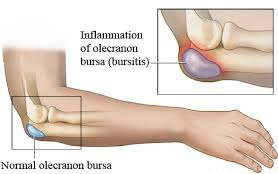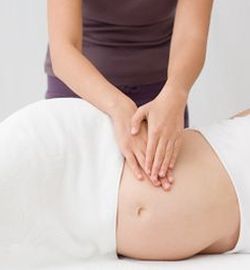Elbow pain is classically thought of as Golfer’s Elbow or Tennis Elbow. However, there are other causes of elbow pain that should be considered, depending upon your symptoms.
Tennis Elbow
Tennis Elbow, also known as Lateral Epicondylitis, is a condition that causes pain on the outside of the elbow. It is typically described as an overuse injury resulting in inflammation and degeneration of the common extensor tendon. This condition can offer complexities that involve several muscles harboring latent and active trigger points, as well as inflammation and tearing in the periosteum at the attachment site of the common extensor tendon.
Muscles most often involved in Tennis Elbow:
- Supinator Pain is felt at the lateral epicondyle and sometimes on the dorsal side of the web of the thumb when the trigger point is active. Elbow pain may be felt at rest
- Extensor Digitorum

- A latent trigger point in the middle finger extensor is often found in cases of Tennis Elbow. When active, this trigger point refers pain down the forearm and into the middle finger.
- Active trigger points in the little and ring finger extensor portion of this muscle refer pain to the lateral epicondyle, as well as down the forearm and into the ring finger

- Trigger points in the ring and little finger portion create pain at the elbow with a firm grip. When the middle finger is involved, there may be weakness in grip without pain at the elbow during that action.
- In addition to elbow pain, patients may complain of stiffness in the finger joints and/or finger cramping
General Symptoms of Tennis Elbow
- Usually a gradual onset of pain at or just distal to the lateral epicondyle of the
 humerus
humerus - Pain when gripping (especally with ulnar deviation, as in shaking hands or when supination is added to the grip, as in turning a screwdriver)
- Weakness in grip
- Pain putting the arm behind the back or bending elbow in some cases
- Pain when supinating or pronating the forearm in some cases
- Edema may be present
- Pain at night in chronic cases
- Muscle atrophy in chronic cases
- Sharp pain at the tip of the lateral epicondyle, especially with use of then hand and when applying pressure to this area
- Pain carrying or lifting objects
- Pain extending the hand and/or fingers
Causes of Tennis Elbow
- Repetitive movements of the wrist or squeezing of the hand
- Trauma to the lateral elbow
- Spondylosis on the levels of C6-C7
Painful Periostal Trigger Point!
 In many cases of Tennis Elbow, the periosteum (outer layer of bone) on the lateral epicondyle is involved. Tension in the extensor group pulls at the periosteum, which contains nociceptive (pain feeling) nerve endings and is very sensitive. With chronic tension, the periosteum becomes inflamed and painful. Treating the periosteum becomes critical because it causes sharp pain and weakness (due to pain inhibition).
In many cases of Tennis Elbow, the periosteum (outer layer of bone) on the lateral epicondyle is involved. Tension in the extensor group pulls at the periosteum, which contains nociceptive (pain feeling) nerve endings and is very sensitive. With chronic tension, the periosteum becomes inflamed and painful. Treating the periosteum becomes critical because it causes sharp pain and weakness (due to pain inhibition).
Treatment of a the periostal trigger point is done after tension has been removed from the muscles. It requires the use of friction directly on the bone (performed with the tip of the thumb or a  knuckle) where the periostal trigger point is found. This treatment takes only a few minutes, but is very painful. However, the results are phenomenal!
knuckle) where the periostal trigger point is found. This treatment takes only a few minutes, but is very painful. However, the results are phenomenal!
Other muscles that may become involved in chronic Tennis Elbow:
- Extensor carpi radialis brevis- Tension in this muscle can also contribute to
 Tennis Elbow. However, its trigger point refers strongly to the wrist.
Tennis Elbow. However, its trigger point refers strongly to the wrist.

2. Triceps- trigger points in the lateral portion of the medial head refer pain to the lateral epicondyle. Posterior elbow pain may be caused by an attachment trigger point that refers strongly to the olecranon. The long head of the triceps refers pain to the posterior shoulders as well as below the lateral elbow.
3. Anconeus- refers pain to the lateral epicodyle
4. Biceps brachii and brachialis- the involvement of the biceps brachii and brachialis muscles is likely due to their synergistic relationships with the supinator and brachioradialis muscles, and antagonist relationship with the triceps brachii. Secondary trigger points may develop in the biceps brachii and brachialis muscles in cases of Tennis Elbow.


Golfer’s Elbow
![]()
Golfer’s Elbow (Medial Epicondylitis) is the same type of condition as Tennis Elbow, except the pain is felt on the medial side of the elbow.
The muscles most commonly involved in Golfer’s Elbow include:
- Flexor carpi radialis
- Pronator teres
Golfer’s elbow is typically caused by repetitive movements of the wrist or squeezing with the hand. It can also be caused by direct trauma to the inside of the elbow.
There are three main ligaments that support the elbow joint– the medial collateral ligament, the lateral collateral ligament and the annular ligament. Injury to any of these ligaments results in an elbow sprain. An elbow sprain may be caused by a forced twist of the arm, falling on an outstretched arm or direct trauma to the area. Symptoms include pain, tenderness and swelling around the elbow. There may be warmth or bruising and a limited range of motion.
Other causes of elbow pain
Olecranon Bursitis (inflammation of the bursa at the tip of the elbow) can occur from trauma, as a result of systemic diseases such as rheumatoid arthritis, or can be due to a local infection. With Olecranon Bursitis, there is typically swelling over the tip of the elbow, yet range of motion of the inner elbow joint is maintained.
elbow) can occur from trauma, as a result of systemic diseases such as rheumatoid arthritis, or can be due to a local infection. With Olecranon Bursitis, there is typically swelling over the tip of the elbow, yet range of motion of the inner elbow joint is maintained.
Nerve irritation
There are 3 nerves that pass through the elbow: the median nerve, the ulnar nerve and the radial nerve. Irritation of any one of these nerves by tensed neck or anterior chest muscles can result in elbow pain that is often misdiagnosed. Your Medical Massage practitioner can conduct simple tests to rule out or confirm irritation of these nerves. If the test is positive, treatment simply involves restoring the normal anatomical length of the involved muscle(s) to take pressure off the nerve.




 humerus
humerus Tennis Elbow. However, its trigger point refers strongly to the wrist.
Tennis Elbow. However, its trigger point refers strongly to the wrist.
